December Solstice
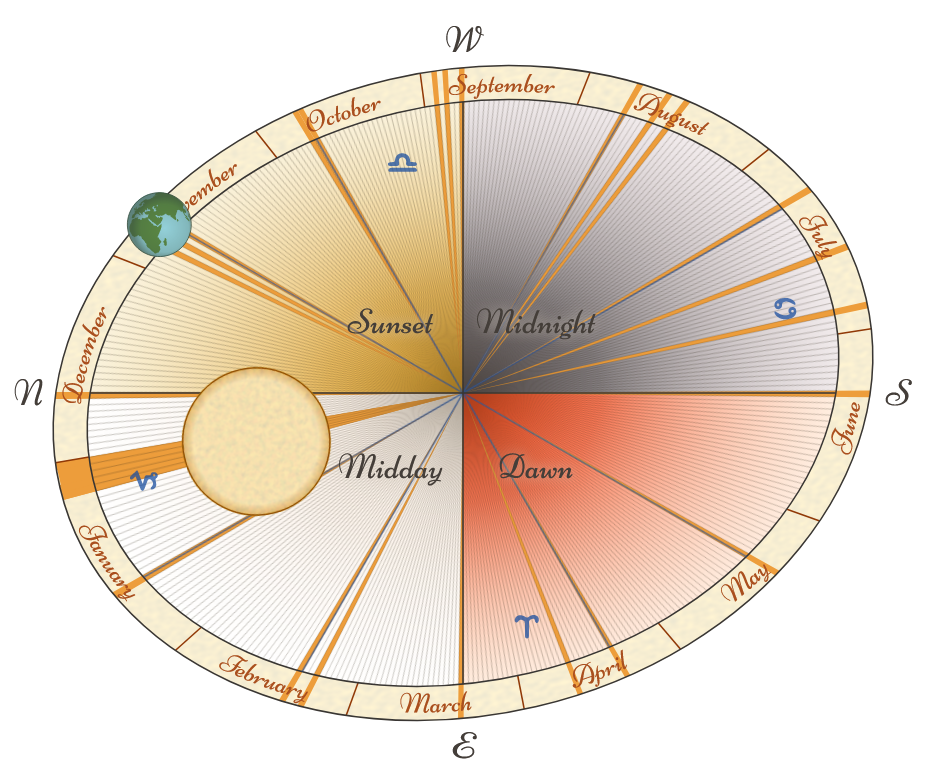
On this December Solstice the earth enters Capricorn, she celebrates Makara Sankranti.
Earth comes closest to her Sun (perihelion, 5 January) in her annual journey through the ecliptic path. Days become longer and the light begins to increase – the opening of the important Festival of Light.
Indian tradition has always given importance to the Earth’s Solstices, these apex points of ‘Uttarayana’ and Dakshinayana’.
These periods of maximum declination north or south of the equator, when the sun appears to stand still in the heavens and change direction – ‘sol-stice’ – give us information about Earth’s purpose in the planetary harmony’ (1). Thea calls this last quarter of Earth’s yearly ‘journey’ around her Sun, Cosmic Midday: the sun is overhead casting no shadows (white in the earth calendar above).
This is the same path our Ancient ones tred to find their dharma. Their hymns sing of this sacred journey based on the cosmic harmonies of our Earth, leading to the summit of the mountain/Capricorn. It was a journey and a yoga in which the entire society participated, a civilisation nurtured on Fulness, centred on Skambha, the Cosmic Pillar (2).
The journey was a travelling upward through periods of cosmic time, or ‘eternal worlds’ as proclaimed by the Rishi. Without effort, one world (or plane of consciousness) opens to the other, as the Vedic Warriors tred Earth’s ecliptic path, ever higher and wider through the months and the years to the Capricorn Mountain peak. This path was the altar of their sacrifice.
The zodiacal sign Capricorn/Makar opens the highest ‘world’ or plane, Cosmic Midday. It is at this last stage of the journey that the soul/Sun is released from Darkness. It is here that the ‘seed’ of knowledge, of Truth, (of Dharma) planted by the Dawn Goddess Usha at the March Equinox, comes into being nine months later at the December Solstice.
And, by the help of the Goddess and her retinue, it is during this time, under the midday sun which casts no shadows, that the ‘seed’ will burst forth, that a reversal will take place that allows Swar (heaven) to manifest in the Soul (of the warrior, of our Earth) and the Sanatana Dharma to be renewed (ibid).
Everyone knows that something very different lies at the heart of India, a civilization that calls its way of life, ‘Dharmic’, Thea writes. But what makes it ‘sanatana’ or the eternal Truth? There is ‘a stable constant upholding the old and the new’: In the human being, this constant is known as the Soul; by birth on earth, we carry this eternal knowledge within us, within our Soul, and our sojourn on this planet is for the purpose of releasing and realizing the ‘dharma’ we carry within us.
In the civilization it is the evolutionary process which provides the means for an ongoing transformation, or a ‘becoming of the being’ (3).
Part Two
Retrieving the Vedic Knowledge
When the ‘great sleep’ swept across the earth in the 8th Manifestation, Earth lost the knowledge, rooted in the cosmic harmonies of our earth. Layers of residue covered the original Vedic source. Other civilisations, such as Egypt, preserved her cosmic truths in stone and cement, the Pyramids; India’s knowledge went underground, preserved in her mythology. As a separation between science and the sacred deepened, with only occidental thought considered to be rational, scientific and verifiable, India suffered a great loss. The traditional myths of the Vedic and Puranic cosmology were definitely in danger of being relegated to mere superstition (4) (5).
Thea takes us deeper: at stake was and is the very survival of Bharat as a civilization. Contemporary Indian society is in a very different place than it was in the millennia when the Dharma evolved and guided the people of the subcontinent. The work of Avatar Sri Aurobindo, in this 9th Manifestation (Note 1), is far more complex than during Sri Krishna’s and Sri Ram’s manifestation (6000 or 12,000 years ago respectively): the earth grapples now with the establishment of organized, orthodox religions, which was unheard of in the ancient world (6).
India is struggling to find a way to carry the Dharma forward to a new phase, in the very midst of a world whose goals are incompatible with the India of the Vedic Age. How can she find an ‘order’ that is Universal, and one that escapes the constraints of religion, Thea asks. How can the essence of the ‘dharma’ – the knowledge preserved in the cosmic harmonies of our earth – be brought forward intact, using the same Laws and Methodology?
As a cosmologist who has dedicated her life work to these studies, Thea answers these important questions from a different perspective; she gives us details of how an Updating of the Dharma can be done, and IS being done during this period of great transition. A shift in the purpose of evolution is taking place as the mental human race is being propelled to a higher status on the evolutionary ladder.
*
A successful Updating must find ‘the thread’ that existed in the Veda, the link that can be carried over intact across the centuries. Thea explains that she found that thread – it is Capricorn/the Mountain. It comes from the 12 part division of the zodiac: the 10th sign is Capricorn, the Mountain (ibid, ch 4)
The mountain was the focus of the Vedic Sacrifice, or Journey; it was so important that the Rishis proclaimed the victory of the Aryan Warrior on the path of initiation to be in the 10th month of the journey (after the March Equinox) – in the month of Capricorn.
As the Vedic Way was forced underground for protection and preservation, the initiation (or the ‘journey’) fell into disuse. But the mountain symbol surfaced again in the Puranic Age, openly displayed as the gopuram of the Temple; ‘form overtook essence’ as grand Temples arose to symbolize the Mountain (ibid). Later, Mt Meru, axis of the world – the Cosmic Pillar – became the predominate myth of India, epitomizing its highest truth.
Thea points to the difference between the mountain in the Vedic Age and the mountain in the Puranic Age as the decline set in (ibid, ch7). Mt Meru of the Puranic Age (see Note 2), the golden mountain in the centre of the universe, was a vision; it’s principle value was in its symbolism. The myth, as all the Puranas, was ‘heavenly’ in nature, i.e., Mt Meru stood as a symbol for Bharat, as a symbol for India as the central axis of the earth. The myth was not intended to be factual or applicable, rather it conveyed a sense of the higher Cosmic Order of the Universe .
Whereas the Vedic sacrifice was entirely physical, of the Earth, and it could be measured. The initiates on the path tred through the ecliptic with the Earth as she circled around her sun each year. This journey of 12 months, supported by the Solstices and Equinoxes, became the altar of their sacrifice. The goal, or the Victory (immortality) could be assured to those initiates who could endure during the most dangerous period, from the 9th through the 10th month.
Part Three: Closing the Cycle, Returning to the Vedic Source
The mountain continues to be immensely significant for contemporary societies – the entry of the Sun into Makar/Capricorn, every year without fail, occurs on the 21-22 December Solstice. (ibid, ch6)
Thea establishes that Capricorn, the Mountain, is the link, the thread which uninterruptedly connects present day societies to the Ancient Mysteries. She locates the Capricorn hieroglyph on Earth: she takes it out of the heavens and gives it a physical body, i.e., she joins heaven and earth: referring to Revelations of St. John, she gives us ‘a new heaven and a new earth’.
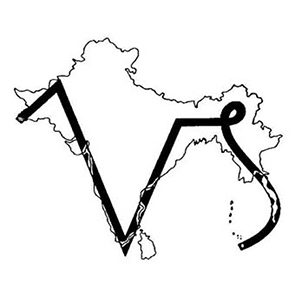
In this Age of Supermind, with the coming of the 9th evolutionary avatar, Sri Aurobindo and his Solar Line, the direction of the quest has been reversed, heaven is brought to earth, ‘heaven has been made new’ (ibid, ch.7). No longer can our Earth be viewed as merely a stepping stone for a better place after death, to a heaven (Swar), elsewhere.
Mount Meru is no longer merely a symbol of India as the axis of the earth, India is the soul-centre of the Earth, by destiny she is to play a special role among the family of nations. The mountain/Capricorn is not a symbol, representing or standing in for something else. India must become the symbol, She must tred the same path as our ancient Ones, she must become the mountain/Capricorn.
‘… the issue is to become conscious participants, thereby fulfilling the dharma of the Age: universal transformation.’ (ibid)
In the Vedic times, the Journey was restricted to the Initiate, the Warrior. There was exoteric knowledge for society in general, and esoteric for the Initiate, but the ‘binding element’ was the 12 month Calendar, the Divine Measure of the Year (ibid, ch. 18). Thea explains that the ‘knowledge’ was restricted to the elite, the realization of the Truth… the sense and purpose embedded in the Sacrificial Year . But this knowledge was passed on to the civilisation through the Calendar, ensuring that ALL members of the society were united around the central axis of the Sacrifical Year .
As the split between science and the sacred deepened, the Vedic tropical zodiac became undermined. By the 6th century CE, a degeneration had set in, the esoteric knowledge derived from the cosmic harmonies was already weakening. In the last several centuries, with the adoption of the Nirayana/Sidereal Calendar, the Vedic Tropical/Sayana calendar fell into disuse. Instead of using earth’s own path around the Sun through the ecliptic, Pundits shifted their observation and measurements for temple timings out to the Constellations in the distant heavens.
India no longer celebrates two of its outstanding landmarks in consonance with the cosmic harmonies of the Earth: Mahavishuva (March Equinox) and Makar Sankranti (December Solstice) are celebrated 23 days late. Thea explains that lacking a foundation in higher knowledge, the pundits are measuring the ‘sankrantis’ in the wrong circle. Both calendars are important (see Note 3); you must know what you are looking for: there is an individual destiny and a universal destiny (Ibid, ch.15). The sidereal/constellational calendar is used to measure the large cycles of our universe, the Astrological Ages (we are now in the Age of Aquarius), based on the Precession of the Equinoxes.
But for temple timings and individual horoscopy, Earth’s own measure – the Tropical Vedic Calendar – must be used. There is no Vedic knowledge in the Nakshatras (of the sidereal calendar); there are no solstices and equinoxes in the constellations. Knowledge of the Capricorn /Mountain is found only in the tropical zodiac which is the script for the ‘initiate’s journey’.
Part Four One nation, One Earth, One Calendar
The structure of the Vedic Journey is depicted in the graphic below (right): the four stages are the physical, the vital, mental and spiritual. But Thea explains, the last quarter cannot be called ‘spiritual’ any longer:
‘… after the Earth-rooted orientation had been lost in the dark age, ‘heaven/swar had to be a plane beyond our material universe; there were no means to prove otherwise. The yogic realization that could do so – the Vedic – had fallen into oblivion. What remained is the collection of the four Vedas, most of which are incomprehensible…’ (ibid, ch 17).
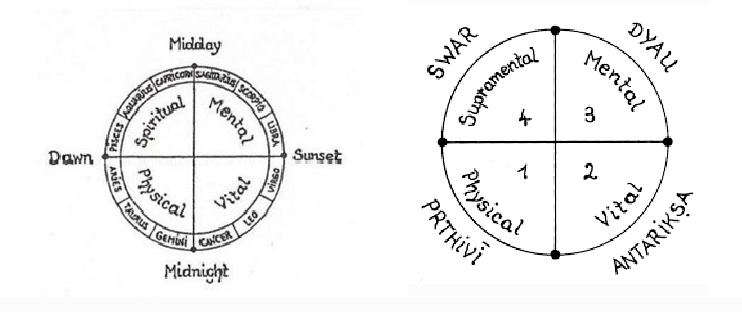
Based on the new cosmology, the plane of consciousness above Mind is now designated as the ‘Supramental’. This great ‘turning point’ in the long journey in the ascending scale of consciousness was made possible by the descent of the Evolutionary Avatar, as Thea calls these special incarnations. It has been opened by the coming of Sri Aurobindo, the 9th Evolutionary Avatar of Vishnu.
Thea states ‘this is the great rahasya of the Veda’, beyond our recognition because of so much accumulated baggage over the last Piscean Age (ibid, ch 20). The Dharma of our 9th Manifestation is to put aside biases, to go beyond ignorance and to open, in this Age of Aquarius, to the full knowledge, the full journey.
The entire last quarter of the journey is to be part of our human experience here on Earth: the last three signs of the zodiac, – ‘the kingdom of Swar’ – are to be lived by all people on our planet, as part of the journey of life. The last and highest stage, opening with Capricorn, ‘the mountain summit of the journey,’ is of this Earth, not beyond our Earth. The human experience is not meant to end at Scorpio, the sign of Death. In the diagram above, the location of Swar is clear, it is located in the last quarter, which opens with Capricorn. It is three signs after Scorpio.
Thea reminds us of Sri Aurobindo’s revelations (Secrets of the Veda): the movement from the 9th to the 10th month was the most dangerous passage of the Vedic journey, it was during this time that the Sons of Darkness reared up and tried to halt the journey of the warrior (ibid). When the Rishi proclaims the ‘victory’ of the ‘dashagwas’ in the 10th month of Capricorn, he refers to those warriors who could prolong their tapasya, who could enter the ‘mountain’ of their soul, confront their inner darkness, and release the hidden (sun) light, their ‘dharma’.
*
Thea turns to Sri Aurobindo’s translation of RV 1, 154, to show that the Line of Evolutionary Avatars originated in the Veda, not later. This hymn of praise describes the unfolding of the last three stages of Vishnu’s avataric appearances (ibid ch 12).
Of Vishnu now I declare the mighty works, who has measured out
the earthly worlds and that seat of our self-accomplishing he supports,
he the wide-moving, in the threefold steps of his universal movement.
That Vishnu affirms on high by his mightiness and he is like a terrible LION
that ranges in the difficult places, yea, his lair is on the mountain-tops,
he in whose three wide movements all the worlds find their dwelling-place.
Let our strength and our thought go forward to Vishnu the all-pervading,
the wide-moving BULL whose dwelling-place is on the mountain,
he who being One has measured all this long and far-extending seat
of our self-accomplishing by only three of his strides.
He whose three steps are full of the honey-wine and they perish not
but have ecstasy by the self-harmony of their nature; yea, he being One
holds the triple principle and earth and heaven also, even all the worlds.
May I attain to and enjoy that goal of his movements, the Delight,
where souls that seek the godhead have the rapture; for there in that highest step
of the wide-moving Vishnu is that FRIEND of men who is the fount of the sweetness.
Those are the dwelling-places of ye twain which we desire as
the goal of our journey, where the many-horned herds of Light go travelling;
the highest step of wide-moving Vishnu shines down on us here
in its manifold vastness.
(RV, I, 154, Sri Aurobindo’s translation)
Thea notes that Sri Aurobindo used capitalisation to emphasise Vishnu’s famous Three Strides of the Universe: first Lion, then Bull, then Friend. It became obvious to her that the three strides in the legend of Vishnu Trivikrama were referring to ‘steps’ across aeons of Time, i.e., to the last three avataric descents, Sri Ram, Sri Krishna and Sri Aurobindo. Vishnu’s own sign is Preservation.
The Rishi points to the signs of the zodiac known as PRESERVATION (in the triad, Creation, Preservation and Dissolution) – and in the correct order. Movement opens in the Age of Leo, the Lion, followed by the Age of Taurus, the Bull. The final and last stride was in our very own Age of Aquarius, the Friend, which opened in 1926 (see graphic, Note 1). There is one zodiacal sign of Preservation missing – Scorpio. This is where Vishnu is standing, where he is measuring from; the higher sign of Scorpio is the Eagle, Garuda, or Vishnu’s symbol. (see Thea’s Secrets of the Earth for full discussion)
~End~
Note 1
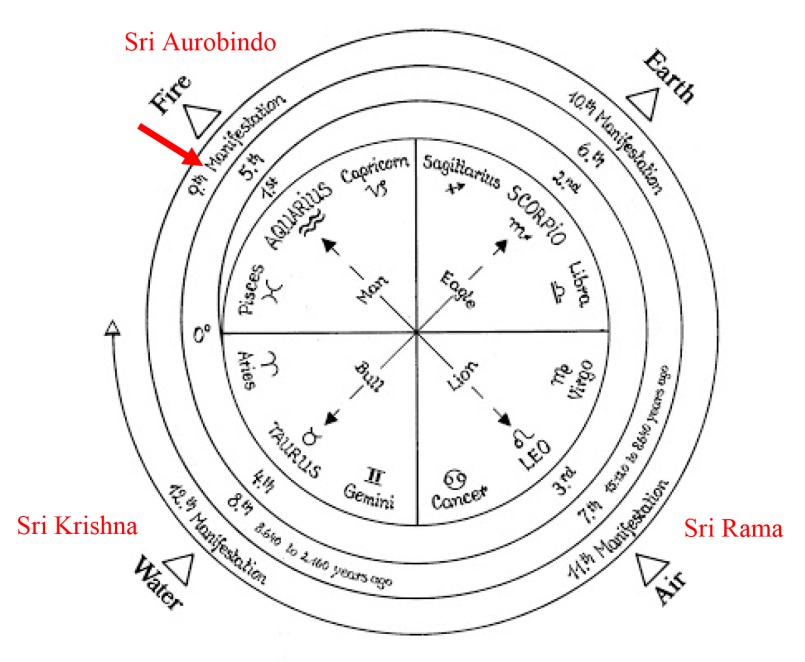
Note 2
Mt Meru was the predominant myth during the Puranic Age – this golden mountain stood in the centre of the universe, it was the axis of the world. It is the abode of the gods, its foothills are the Himalayas, to the south of which extends Bharatavarsa , the ancient name for India…As the world axis Mount Meru reaches down below the ground into the nether regions, and extends far up into the heavens….(Encyclopedia Britannica).
Note 3
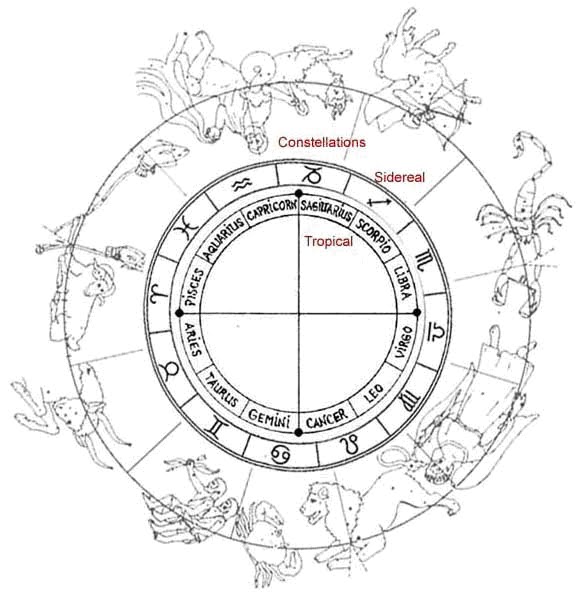
The innermost circle with the zodiacal signs is the Tropical Zodiac, the ONE CIRCLE extolled in the Vedas, with its fourfold division marking out the four Cardinal points of Equinoxes and Solstices. The outermost circle (hieroglyphs) describes the Sidereal Zodiac, the one currently used by Nirayana pundits which is the constellation of fixed stars far beyond our solar system.
References
- Patrizia Norelli-Bachelet, The Vishaal Newsletter, Volume 6, number 6, February 1992
- Patrizia Norelli-Bachelet, The Vishaal Newsletter, Volume 7, number 1, April, 1992
- Patrizia Norelli-Bachelet, Puranic Cosmology Updated, 2010.
- Anirban Choudhury, Dharma, the Future of Human Civilisation, The Tribune, 30 October 2021.
- Rakesh Muduli and Sri Devasis Mishra, Essence of Revival of Hindu Civilisation, The HinduPost, 30 June, 2021
- Patrizia Norelli-Bachelet, Puranic Cosmology Updated, op cit.
